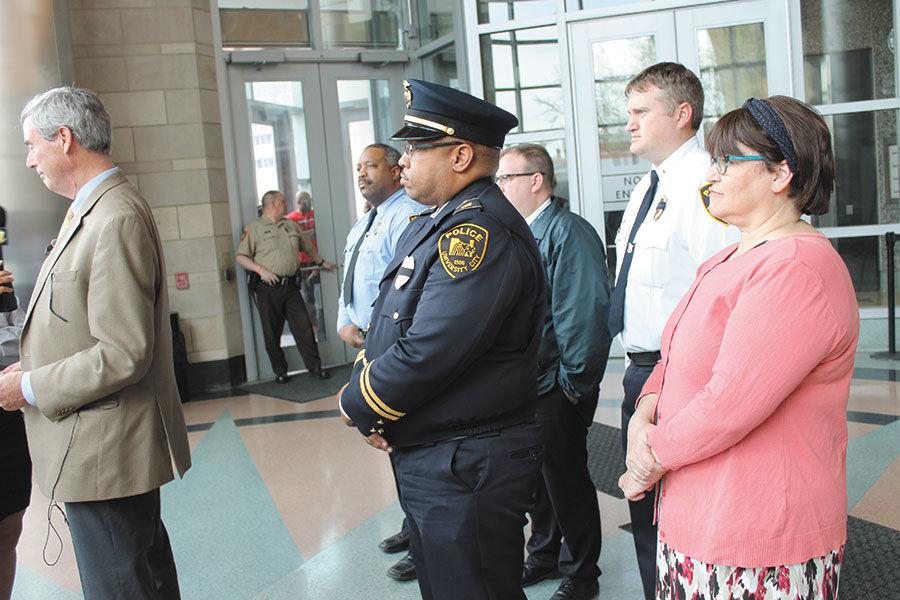Florissant man confesses to cemetery vandalism
Published May 2, 2018
Despite more than a year passing since the vandalism at Chesed Shel Emeth cemetery, University City police had not conceded that the perpetrator or perpetrators would elude them, according to Captain Fredrick Lemons.
There was a reason for that optimism. Police had obtained DNA from a jacket left underneath one of the more than 150 headstones that were damaged or knocked over in February 2017.
Last week, law enforcement found an alleged match with Alzado Harris, a 34-year-old man who was required to provide a DNA sample in December when he entered prison for a different crime. On April 24, police arrived at Harris’ home in Florissant; he agreed to talk with them about the crime and later confessed.
At that point, police arrested Harris and charged him with institutional vandalism, a class D felony. If convicted, the crime carries a jail sentence of five to 15 years.
“It’s pretty common” for there to be such a delay, Lemons said. “People have to understand that it’s not like on TV; sometimes these things take time.”
Harris, who had a number of previous arrests, told police that he was angry after an argument with a friend and was drunk and high on marijuana when the crime occurred, according to St. Louis County Prosecutor Robert McCulloch. His friend dropped Harris off near the cemetery. Anti-Semitism did not appear to be a motivating factor, the prosecutor said.
At the time of the vandalism, Philip Weiss, president of Rosenbloom Monument Company, which reset the headstones, said it would take five guys of average height and weight 15 minutes to topple 150 of them.
“We wanted to bring this to a conclusion. We wanted to make sure that the citizens felt safe,” said Lemons. Harris is now being held at the St. Louis County Justice Center on a $20,000 bond.
Despite the fact that the police and the prosecutor’s office said anti-Semitism was not the motive behind the crime, that notion appears to have already taken hold in the Jewish community.
The Anti-Defamation League had included the incident on its list of anti-Semitic incidents in its 2017 audit. It also used images of the headstones laying on the ground at the start of a recent video on the dramatic rise in anti-Semitism.
The cemetery vandalism occurred after Jewish Community Centers around the country — including centers in St. Louis — received a string of bomb threats. But also in those cases, the alleged perpetrators — an Israeli teen with, according to his father, severe autism and a brain tumor; and a former journalist from St. Louis trying to harass and frame an ex-girlfriend — did not appear to be motivated primarily by hatred of Jews.
“ADL was waiting to learn whether or not the case would be prosecuted as a hate crime, which requires evidence of motivation that Harris chose the cemetery intentionally because it was a Jewish one and he wanted to target Jews,” Karen Aroesty, ADL regional director, said in a statement. “It appears that such motivation is not present …. While it won’t be prosecuted as a hate crime, there is no question that at the time it certainly felt hateful to the Jewish community, both in St. Louis and far beyond.”
Chesed Shel Emeth Society Executive Director Anita Feigenbaum said she was “glad it’s not anti-Semitic. There is too much of that going on; on the other hand, it’s just sad that any kind of vandalism of this sort would happen.”
Not everyone in the Jewish community accepted the prosecutor’s determination that anti-Semitism did not play a role in the vandalism.
“Why would a guy just go in there and turn over graves?” said Jeffrey Korn, 80, a member of Congregation Temple Israel. “Even if you get dropped off there — even if you’re intoxicated — you go in there, you see all the Stars of David, you see all the Hebrew writing, you still keep knocking them over and doing all that damage? It’s pretty sad.”
Regardless of the motive, news of the vandalism and other crimes involving Jewish victims have sparked fear among some members of the Jewish community.
When Lainey Asadorian heard about the vandalism, she said she “immediately thought” about her son, who attends the preschool at Congregation B’nai Amoona. “It’s just a scary world, and it scares me to think about what it’s going to be like in 10 years for my kid, being Jewish.”
Despite those concerns, there were also those who pointed to the positive response to the vandalism. Afterwards, a pair of Muslim activists raised more than $140,000 to help with repairs at the cemetery, and Gov. Eric Greitens organized a clean-up that drew more than 1,000 people, including Vice President Mike Pence.
“I hope that now that we know the facts of what happened, we can begin to shift away from the perpetrator and view this episode more for the beautiful outpouring of friendship and community and togetherness that this elicited,” Rabbi Levi Landa, director of programming for Chabad of St. Louis stated in an email. “That is the true story here.”















